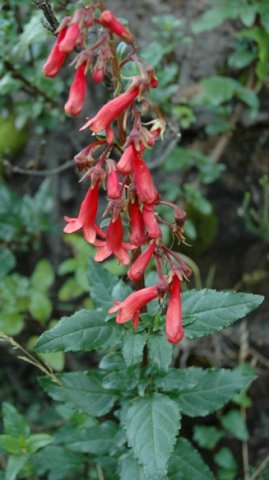Phygelius capensis

Author: Ivan Lätti
Photographer: Johan Wentzel
Phygelius capensis, commonly known as southern river bells, is a cold resistant shrub reaching 1 m in height. Phygelius is a genus of flowering plants forming part of the Scrophulariaceae or snapdragon family. There are two species of them in South Africa.
The simple, opposite, stalked leaves are elliptic with pointed tips and toothed margins. The midribs and upcurving lateral veins are sunken on the upper surfaces of the leaves.
Some of the red flowers in picture have more distinctly curved or abruptly bent tubes, widening to the tips. The odd angles of some flower tubes in the panicles may be intriguing. There is little evidence of protruding stamens. The buds are slightly club-shaped. The narrow calyx lobes veer away from the back ends of the corolla tubes.
The species distribution is mainly inland in the southeast of South Africa, centering around Lesotho. It occurs in the north of the Eastern Cape, the east of the Free State, the west of KwaZulu-Natal and to a lesser extent in the Western Cape and Mpumalanga. The photo was taken near Rhodes.
The habitat is high altitude, mountain streambanks and moist patches. The habitat population is deemed of least concern early in the twenty first century.
The plant is commonly cultivated as an ornamental, valued for flowering a range of colours over a long season. Garden cultivars, some as hybrids between the two South African species have mainly originated in England. This plant is fast-growing, thrives on water and is propagated from cuttings. It tends to clump, growing multiple stems and responds well to cutting back during the dormant winter season (Manning, 2009; Joffe, 2001; iNaturalist; http://redlist.sanbi.org).

